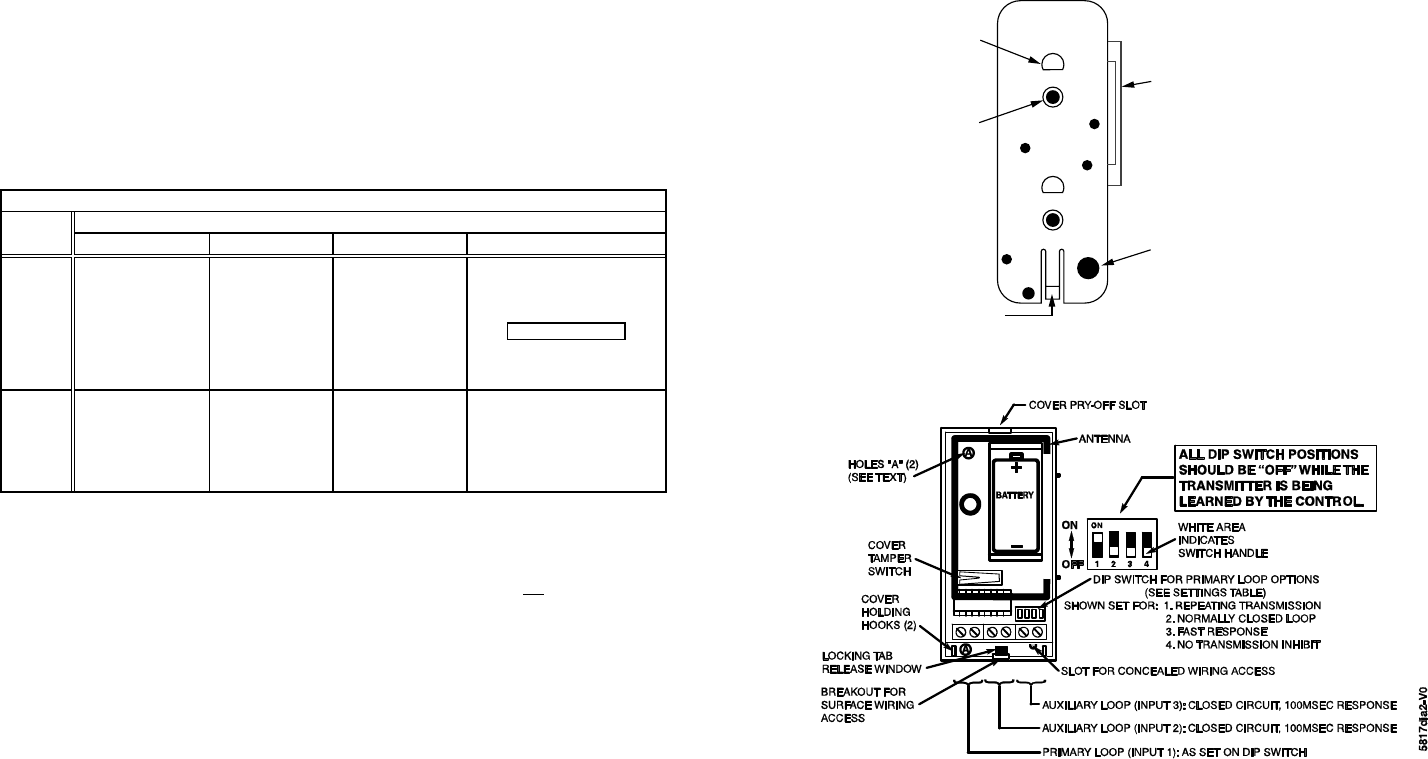Ademco 8DL5817-1 remote security transmitter User Manual N6483V4 draft ii
Honeywell International Inc. remote security transmitter N6483V4 draft ii
Ademco >
II with fcc part 15 statment

TO THE INSTALLER
Regular maintenance and inspection (at least annually) by the installer and frequent testing by
the user are vital to continuous satisfactory operation of any alarm system.
The installer should assume the responsibility of developing and offering a regular maintenance
program to the user, as well as acquainting the user with the proper operation and limitations of
the alarm system and its component parts. Recommendations must be included for a specific
program of frequent testing (at least weekly) to ensure the system's operation at all times.
FCC ID: CFS8DL5817-1
THIS DEVICE COMPLIES WITH PART 15 OF FCC RULES. OPERATION IS SUBJECT
TO THE FOLLOWING TWO CONDITIONS: (1) THIS DEVICE MAY NOT CAUSE
HARMFUL INTERFERENCE, AND (2) THIS DEVICE MUST ACCEPT ANY
INTERFERENCE RECEIVED, INCLUDING INTERFERENCE THAT MAY CAUSE
UNDESIRED OPERATION.
CANADA: 573F-58171
FOR WARRANTY INFORMATION AND LIMITATIONS OF THE ENTIRE SYSTEM, SEE
THE INSTALLATION AND SETUP GUIDE FOR THE CONTROL /RECEIVER WITH
WHICH THIS DEVICE IS USED.
165 Eileen Way, Syosset, New York 11791
Copyright © 2004 Honeywell International, Inc.
www.honeywell.com/security
ÊN6483V4uŠ
N6483V4 4/05 Rev. a
N6483V4 4/05 Rev. A
ADEMCO 5817
MULTI-POINT UNIVERSA
L
TRANSMITTE
R
INSTALLATION AND SETUP GUIDE
GENERAL INFORMATION
The 5817 Multi-Point Universal Transmitter may have three contact loops connected to it. Each
loop transmits a unique ID code to a 5800 wireless system receiver connected to the system
control panel. The Primary Loop has several DIP switch selectable options that determine its
connection requirements, response, and transmission characteristics (see DIP switch setting
table on next page). The two Auxiliary Loops are closed-circuit, with a nominal response time of
100mSec. For UL installations, no contact in any of the loops may be more than 3 feet from the
transmitter.
A built-in cover tamper switch is activated when the cover is removed.
ENROLLING THE TRANSMITTER IDs
The 5817 has its own unique identification codes permanently assigned during manufacture. It is
not necessary to program the transmitter IDs during installation. Instead, the control unit is
required to "enroll" the transmitter IDs at some point prior to the transmitter's usage in the alarm
system.
The control unit's installation manual contains general information on the "enrolling" procedure,
but the information given herein pertains specifically to the 5817.
1. Place a 3V battery in the battery holder, as described later in BATTERY
INSTALLATION/REPLACEMENT and as shown in Diagram 2. Observe polarity!
2. Make sure that the DIP switch's 4 positions (see Diagram 2) are all OFF.
3. Set the system ready for enrolling the ID code of one of the 5817's loops (inputs) to be
used, as described in the control's instructions. The 5817 should be treated as "RF" (i.e.,
supervised RF) Type (mandatory for UL installations).
4. Proceed with enrolling the inputs of the loops to be used, as described in the control's
instructions.
INSTALLATION
Mounting
For proper orientation of the unit in relation to its wall mounting plate and the loop wiring, read all
of this section before installing the unit.
The description that follows assumes that the unit will be mounted as shown in the diagrams. The
unit may, however, be installed in any direction, as long as the relationship of the unit to its
mounting plate is maintained.
Although two holes are provided in the unit that would permit mounting directly to a surface (holes
"A" in Diagram 2), it is recommended that the mounting plate be used, as described below, for
ease in removing the unit for servicing should it become necessary.
Before mounting the transmitter permanently, conduct Go/No Go tests (see control's instructions)
to verify adequate signal strength and reorient or relocate the transmitter if necessary. When a
satisfactory location is found, remove the battery and proceed with installation.
1. Remove the transmitter's cover by inserting the flat blade of a small screwdriver into the
pry-off slot at the end of the unit farthest from the cover's decorative ribs, and twisting the
blade. Note: The open slot at the other end of the unit cannot be used as a cover pry-off.
2. Disengage the supplied mounting plate from the unit by inserting the blade of a small
screwdriver into the locking tab release window (see Diagram 2) and pressing it against the
case locking tab (see Diagram 1) while sliding the plate downward along the case back. Note:
For this application, the alignment guide strip along one edge of the plate serves no function
and may be broken away, if desired.

— 2 — — 3 —
3. If concealed wiring is to be used, feed the wires through the concealed wiring entry hole at
one corner of the plate (surface wiring is mentioned in Step 5 below).
4. Install the mounting plate, with its case holding posts pointing up (in this example), in the
location selected as described in the control unit's installation instructions. Use the flat-head
screws supplied.
5. If concealed wiring is to be used, feed it through the slot in the case back but do not connect
to the terminal block yet. Surface wiring should enter via the thin "breakout" area provided in
the case wall.
6. Attach the case back to the mounting plate by sliding the keyhole slots in the case back down
onto the mounting plate's hooks. The locking tab will click as the case back locks in place.
7 Set the DIP switch (after the control has enrolled the transmitter's input IDs) for the desired
primary loop characteristics, as described in the table below.
P R I M A R Y L O O P O P T I O N S T A B L E
SWITCH D I P S W I T C H P O S I T I O N
SETTING 1 2 3 4
ON REPEATING
TRANSMISSION
(every 4 sec.)
UPON PRIMARY
LOOP FAULT
Use for high-priority
alarm, such as fire.
NORMALLY
OPEN CIRCUIT
PRIMARY LOOP
SLOW
PRIMARY LOOP
RESPONSE
(Approx. 200mSec
Normally Closed
Response Time)
3 MINUTE, ALL LOOP
TRANSMISSION INHIBIT
AFTER RESTORE OF
PRIMARY LOOP
See Note c.
This affects the Aux. loops as
well. Use on frequently used
doors, etc. to conserve battery.
OFF SINGLE
TRANSMISSION
PER PRIMARY
LOOP
CHANGE-OF-
STATE
NORMALLY
CLOSED
CIRCUIT
PRIMARY
LOOP
FAST
PRIMARY LOOP
RESPONSE
(Approx. 5mSec
Normally Closed
Response Time)
NO
TRANSMISSION
INHIBIT
Notes: a. While the transmitter is being enrolled by the control, all DIP switch positions should
be OFF.
b. Except in the case of the position 4 ON setting, the Auxiliary loops are not affected by
the DIP switch settings.
c. For UL installations with fire zones, the position 4 ON setting must not be used.
WIRING CONNECTIONS
With the battery still not inserted, connect the loop wiring to the unit's terminals (see Diagram 2).
Note: If a contact loop is not to be used, no connection is needed across its terminals.
BATTERY INSTALLATION/REPLACEMENT
1. Remove the transmitter's cover (if not already off) as described in Mounting Step 1.
2. Observe correct polarity and insert the battery provided into the battery holder (see
Diagram 2). Take care not to bend the antenna.
Note: Replace battery only with: Duracelll DL123A, Sanyo CR123A,
Panasonic CR123A, ADEMCO 466, or Varta CR123A.
CAUTION: Risk of fire, explosion, and burns. Do not recharge, disassemble, heat above
212°F (100°C), or incinerate. Dispose of used batteries promptly. Keep away
from children.
3. To replace the cover, engage the hooks along one edge and snap shut.
SPECIFICATIONS
Dimensions 1-9/16"W x 3-1/2"H x 1-3/16"D (40mm x 89mm x 30mm)
Battery 3V Lithium (see BATTERY INSTALLATION/REPLACEMENT).
CASE
HOLDING
POSTS (2)
PLATE
MOUNTING
HOLES (2)
ALIGNMENT GUIDE STRIP
(NOT USED IN THIS APPLICATION.
BREAK AWAY, IF DESIRED.)
CONCEALED WIRING
ENTRY HOLE
CASE LOCKING TAB
Diagram 1: MOUNTING PLATE
Diagram 2: 5817 (SHOWN WITH COVER REMOVED)